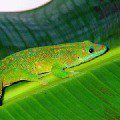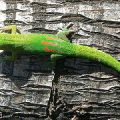
Gecko madagascar
The Madagascar flat-tailed gecko, along with the common gecko, belongs to the celebrities of the tropical fauna because of its amazing appearance. It has the unique ability to change body color depending on ambient temperature and lighting. In the sun, the Madagascar gecko is deep green, and in the shade it can easily turn olive, brown, or even lose its green and put on a gray outfit. In bright sunlight, the body of the lizard takes on a lemon hue, but if you look at it against the light, the gecko is already aquamarine with a deep blue tail. This flat-tailed lizard is named for its wide and flattened top and bottom tail with serrated edges. And although the flat-tailed gecko is also classified as a Madagascar species, its habitat is not limited to this island. Broad-tailed lizards are also found in the Seychelles and Hawaii, however, scientists believe that reptiles were brought there, while Madagascar is their natural homeland. In size, flat-tailed Madagascar geckos are inferior to ordinary day geckos, but otherwise they have similar features. Which ones – read in the relevant sections. And of course, these lizards, like day geckos, are popular “exhibits” of terrarium collections. But in order for the flat-tailed gecko to always be alert, healthy and bright, it is especially necessary to maintain a suitable level of moisture in the environment. But for ordinary day geckos, this is not the most important indicator.
Contents
Classification
Kingdom: Animals
Type: Chord
Superclass: Quadrupeds
Class: Reptiles
Order: Scaly
Suborder: Lizards
Infraorder: Geckos
Family: Geckos
Subfamily: True geckos
Genus: Felzumy
Species: Broadtail Phelsuma, Phelsuma laticauda
Appearance
 The flat-tailed Madagascar gecko is a small lizard that grows up to 10-12 cm in length. If you look at it from above, then it all seems to be flattened. Tapering at the end, the head of the Madagascar gecko almost immediately passes into the body, which also smoothly flows into a long and flat tail. The color of the lizard, as mentioned above, is quite variegated, but mainly varies from light to dark green in color with yellow spots on some parts of the body, red stripes on the head and the same spots on the back to the tail. The throat of the felsum is slightly lighter, yellowish, and the abdomen is almost white. Her round eyes have blue edging and soft, ringed lids. In the sun, it sometimes seems that the flat-tailed Madagascar gecko is all as if surrounded by a bluish glow, in fact, the paws and edge of the reptile’s tail cast such a shade under intense lighting.
The flat-tailed Madagascar gecko is a small lizard that grows up to 10-12 cm in length. If you look at it from above, then it all seems to be flattened. Tapering at the end, the head of the Madagascar gecko almost immediately passes into the body, which also smoothly flows into a long and flat tail. The color of the lizard, as mentioned above, is quite variegated, but mainly varies from light to dark green in color with yellow spots on some parts of the body, red stripes on the head and the same spots on the back to the tail. The throat of the felsum is slightly lighter, yellowish, and the abdomen is almost white. Her round eyes have blue edging and soft, ringed lids. In the sun, it sometimes seems that the flat-tailed Madagascar gecko is all as if surrounded by a bluish glow, in fact, the paws and edge of the reptile’s tail cast such a shade under intense lighting.
Jagged scales are located along the edges of the tail of the Madagascar gecko. Five toes on the paws do not have claws, and, despite the fact that the thumb is poorly developed, they are quite tenacious, because this lizard lives in trees. This tenacity is due to the special coating of the fingers on the underside. They have wide plates with attachment brushes arranged in transverse rows. This is why Madagascar geckos can easily walk even on the ceiling of a terrarium.
Males differ from females in large sizes, but the “girls” also have their own interesting feature – on the throat near the cheeks they have small swellings on both sides, called “calcareous warehouses”, where calcium useful for lizards is deposited. These swellings are especially noticeable during the breeding season. You can follow the color change of the Madagascar gecko if you watch it during the day. In open places, where the temperature is higher, the lizard appears in all the glory of its various shades, and in the shade it dims the brightness of the dress.
Distribution and habitation
Despite the name of Madagascar, this gecko settled not only on this island. To be more precise, in Madagascar he lives in the eastern area, and also lives in the adjacent Comoros, the already mentioned Seychelles and Hawaiian Islands. For habitat, the flat-tailed Madagascar gecko chooses forests in the coastal zone. Like diurnal, it can settle on a coconut palm or an exotic banana tree. And just like other day geckos, the Madagascar flat-tailed gecko does not avoid human settlements. You can meet him in the cities of Madagascar, but more often he hides in the shelters of various buildings. In terms of climate, the flat-tailed Madagascar gecko is more picky than the day gecko, it prefers areas with high humidity, where the annual rainfall is 900-1500 ml. Such high humidity is necessary for the lizard to molt normally, therefore it is recommended to create appropriate conditions in terrariums.
Behavior and lifestyle
Flat-tailed Madagascar geckos, like diurnal ones, are territorial, and perhaps even more aggressive towards strangers and their females. For example, if you keep heterosexual geckos alone for a long time, and then plant them together, then a bloody clash with the victims may occur. Therefore, in a terrarium, they are recommended to be kept in groups – one male and several females. In nature, a similar thing happens, only there, of course, there is more space for geckos to live, so each individual has its own territory, but the areas of the male and females usually intersect.
For female flat-tailed Madagascar geckos, a hierarchy is also characteristic, but they can be kept together, since they are still calmer than males. During the day, these lizards lead an active life, deftly moving along their tree or along the walls of the terrarium, if we are talking about a nursery. Therefore, without plants, they simply will not survive. And flat-tailed Madagascar geckos drink very interestingly. To replenish their moisture reserves, they lick the water accumulated on the leaves of plants. Therefore, in nurseries, these lizards do not put drinkers, but simply periodically spray the plants planted for them in the terrarium. Otherwise, the lifestyle of these reptiles is similar to the existence of day geckos. During the day they are alert and active, and the darkness for them is a signal to fade. In the dark, Madagascar geckos do not feed, do not drink, and almost do not move, so they prefer to meet the night in shelters or freeze on the trunk. In the terrarium, the duration of daylight hours is artificially regulated.
In the scientific literature, there are often descriptions of colonies of Madagascar lizards encountered by some researcher on the island. Most likely, these descriptions are just about flat-tailed geckos, heterosexual individuals of which can live close to each other. In other versions, a group of geckos is a rather rare phenomenon and is found only in thickets of soil bromeliad, an exotic plant in Madagascar. This plant never falls off and rotted substrate accumulates around its leaves, which Madagascar geckos use for clutches. On such a tree, a colony of lizards is quite possible.
Food
 Flat-tailed Madagascar geckos are real little gluttons. If you feed them abundantly, then they can easily get fat, which negatively affects the health of lizards, so it is recommended to give them food no more than three, and in winter twice a week. The diet of flat-tailed Madagascar geckos should be mixed, as in nature they adhere to a fruit diet, diversifying it with small insects. These lizards, unlike typical day geckos, are unlikely to eat meat. Their size does not allow them to catch larger invertebrates.
Flat-tailed Madagascar geckos are real little gluttons. If you feed them abundantly, then they can easily get fat, which negatively affects the health of lizards, so it is recommended to give them food no more than three, and in winter twice a week. The diet of flat-tailed Madagascar geckos should be mixed, as in nature they adhere to a fruit diet, diversifying it with small insects. These lizards, unlike typical day geckos, are unlikely to eat meat. Their size does not allow them to catch larger invertebrates.
As for the nutrition of Madagascar geckos in captivity, it is advised to accustom them to plant foods from childhood, otherwise the lizard will refuse it and eventually die from a lack of vegetable protein. Small flattails are especially fond of various sweet-smelling sweets, such as honey or sweet fruit puree. People who are already familiar with the behavior of Madagascar geckos, in case of lack of appetite or indifference to food, are advised to gently and lightly smear honey on the face of the lizard so that it tastes sweet and starts eating at least fruit mixtures.
From fruits Madagascar geckos are recommended bananas, mangoes, persimmons – everything that is soft and sweet. It is better to choose smaller insects – crickets, butterfly larvae. And supplements containing calcium and vitamin D3 are very important for flat-tailed geckos. A lack of calcium can lead to the fact that one day the gecko simply will not be able to move along the walls of the terrarium or he will develop rickets. You can mix vitamin supplements just into fruit pulps.
Reproduction
 Sexually mature males, as it should be in daytime Madagascar geckos, are larger than females. They grow somewhere up to 15 cm. And lizards become sexually mature within a year after birth. Their breeding season is tied to the seasonal cycles of nature and occurs as soon as the temperature rises and the day lengthens. Harems of several females are typical for male flat-tailed Madagascar geckos in the wild. And they will never let another male near their family, and if one approaches, then a fight will happen. And flat-tailed geckos also keep females “in a black body”. There are cases when a gecko who lived alone for a long time, having a fight with a female planted to him, killed her. For such situations, terrariumists have found a rather ingenious way out. They plant a larger female to a small male, capable of giving a worthy rebuff, then reproduction is more likely to happen.
Sexually mature males, as it should be in daytime Madagascar geckos, are larger than females. They grow somewhere up to 15 cm. And lizards become sexually mature within a year after birth. Their breeding season is tied to the seasonal cycles of nature and occurs as soon as the temperature rises and the day lengthens. Harems of several females are typical for male flat-tailed Madagascar geckos in the wild. And they will never let another male near their family, and if one approaches, then a fight will happen. And flat-tailed geckos also keep females “in a black body”. There are cases when a gecko who lived alone for a long time, having a fight with a female planted to him, killed her. For such situations, terrariumists have found a rather ingenious way out. They plant a larger female to a small male, capable of giving a worthy rebuff, then reproduction is more likely to happen.
If mating did occur, the female walks pregnant for about 3-8 weeks, and then carefully hides her masonry in some secluded place – a folded leaf of a tropical plant or a recess in the trunk. The fecundity of flat-tailed Madagascar geckos is estimated at about 4 pairs of eggs per year. During pregnancy, the female eats especially a lot, in terrariums such lizards are fed more often, and in the same place people managed to trace how interesting female flat-tailed geckos lay their eggs. First, the lizard lays 2 eggs, and then holds them with its hind legs until the shell hardens. So the female can hold the clutch for as long as 3 hours! And after laying, the Madagascar gecko is almost immediately ready for further reproduction.
By where the lizard’s nest is located, one can determine whether breeding is successful. Sometimes female Madagascar geckos lay their eggs in open areas, such clutches are most likely not fertilized, and the females subsequently simply eat them. The incubation period for Madagascar geckos lasts about two months, and the babies hatch into the world healthy at high temperatures and high humidity. Moreover, the warmer it is around, the more males are born. Newborn Madagascar geckos are very tiny – no more than 4 cm. In a terrarium, it is better to immediately transplant them from adults, otherwise competition for food will subsequently begin.
Sources of
http://ru.wikipedia.org/
http://www.floranimal.ru/
http://phelsuma.ru/
http://www.zooclub.ru
http://www.apus.ru/
http://www.zooclub.ru





